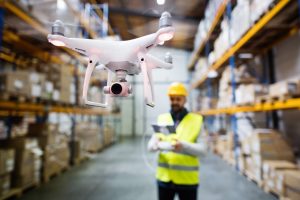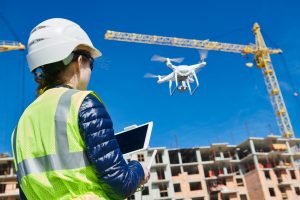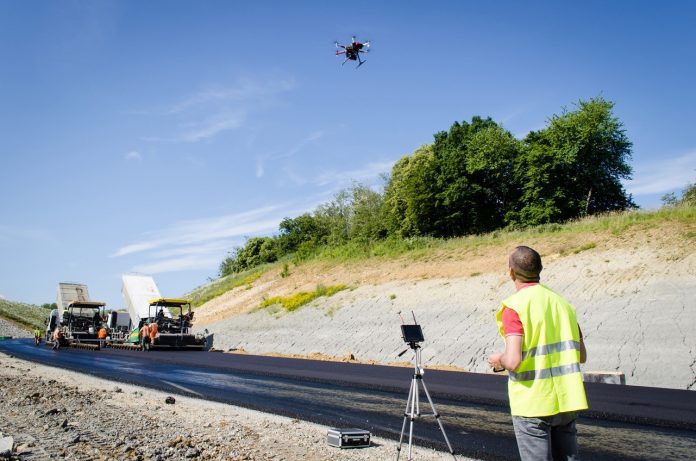Drone technology has been hailed as a game-changer for the construction and engineering industries. But where do the benefits come from – and what are the risks? Senior construction solicitor May Winfield explains where the law stands on drone use
According to a recent report by PwC, drone technology has the potential to increase the UK GDP by £42bn (equivalent to 2%) by 2030.
Meanwhile, Goldman Sachs predicts that the spend between 2016-2020 on drones in construction, agriculture insurance and infrastructure inspection will total almost $20bn.
So where do these large cost and efficiency savings come from and what does this mean for the construction industry?
Currently, the construction industry appears to predominately use drones to record a project’s progress, mapping for software programmes (including for BIM), surveying and monitoring. These processes could include the taking of thermal imaging recordings to give engineers and surveyors essential information when establishing building defects that require rectification.
This, in turn, could have a significant positive impact on a project. Foster + Partners are in fact reportedly working with a drone software developer, Be Tomorrow UK, to develop a prototype for real-time detection of errors on big construction projects. Imagine the potential time and cost savings when this becomes a reality.
There are a number of immediate benefits in the use of drones. Drones enable parties to access hard-to-reach or dangerous areas without the corresponding health and safety risks of inspection by an individual. Real-time data is collated faster than human inspection as well.
Some industry parties have pointed out to the author that the use of drones has facilitated more accurate and cheaper site and progress surveys.
Drones could also provide an important tool to improve data capture for BIM, eg facilitating the creation of a 3D model of a building from its images. Researchers from the University of California are working on a system using drones and Wi-Fi for 3D mapping of objects within buildings. The system, like comic book superheroes, literally sees through walls.
The growing importance of drones is reflected by the issue of the Department for Transport’s consultation paper, Unlocking the UK’s High-Tech Economy: Consultation on the Safe Use of Drones in the UK, which set out various proposals. While a UK Drones Bill is also being progressed, the second reading of this bill has now been delayed to early next year.
The laws and regulations on drones For those new to the requirements and guidelines on drones, the Civil Aviation Authority’s website provides a comprehensive summary of the relevant information.
There are various strict obligations that must be complied with within the statutory requirements, in particular the Air Navigation Order 2016. For example, a person in charge of the drone must “not recklessly or negligently cause or permit an aircraft to endanger any person or property” and “maintain direct, unaided visual eye contact… for the purpose of avoiding collisions”.
A 2018 amendment to the Air Navigation Order 2016, while imposing some new obligations and limitations, clearly tries to strike a healthy balance between ensuring safety while not stifling the use of drones to benefit a range of industries. This reflects both the recognised benefits of drones, as well as the acknowledged risks of irresponsible or negligent use. An example of such irresponsible or careless use being the steady rise in near-miss incidents with planes (92 reported incidents in 2017, up from 71 in 2016 and 29 in 2015).
In light of Brexit, it is worth reminding ourselves that this applies to the UK only. Other European countries have their own rules, regulations and registration requirements. This will be particularly relevant if a construction project is outside UK, as well as where the drone provider/operator comes from a different jurisdiction. The European Authority on Aviation Safety (EASA) is in the process of revamping the regulations on drones, which will have a direct impact on this.
Potential legal issues
Like with all new and innovative technologies, without a body of case law and established principles to provide legal clarity, drones give rise to new legal issues and uncertainties. Some of the potentially main legal issues or potential areas of disputes are considered below.
 Registration, regulations and statutes
Registration, regulations and statutes
As mentioned above, there are various restrictions about the maximum height and flight path of drones, as well as various obligations on the drone operator, such as to keep the drone in their line of sight.
Irresponsible or negligent use of a drone carries with it a risk of criminal prosecution by the Civil Aviation Authority as well as, on a more immediate level, the risk that the Civil Aviation Authority may withdraw the existing permissions of use, in turn impacting a project’s timetable and costs if it was relying on the information obtained from a drone survey, for example.
Privacy and data protection
Drone footage may be subjected to many of the same restrictions and requirements as CCTV footage. This includes the manner of storage and security controls around drone recordings.
The flurry of emails in our inboxes in the months leading up to 25 May 2018 made it impossible to ignore that the General Data Protection Regulation (GDPR) was coming into force. The very nature of drones’ utility involves the capture of data, and the consequent risk of recording personal information.
Consequently, the GDPR could have a significant impact on the operations and data storage for drones where there is any possibility or likelihood of capturing images of individuals, including employees, visitors to site and third parties in the vicinity of the site. Some commentators point out that the issue of compliance with GDPR extends not just to images, but to all personal identifiable information such as locational data. It will be necessary to carefully consider how to minimise these issues, for example by avoiding capturing such personal data or ensuring relevant express consents are obtained.
A privacy impact assessment prior to using drones on site could also help identify privacy risks so that measures can be implemented from the outset to reduce the risk of breaches of the GDPR and other data protection legislation.
Trespass
There is the obvious risk of trespass where a drone flies over a neighbouring property without permission. This is complicated by a lack of case law relating to trespass by drones as yet. However, from a point of principle and common sense, the best analogy to apply may be that of oversailing of crane jibs with the same licences or consents required for drones.
Injuries and property damage
Again, given the relatively new use of drones within the industry, the precise risk allocation for personal injury and property damage is yet to be firmly ascertained. It makes sense to clarify this in the contractual relationship between the various parties, and take it into account in the checks and risk management processes implemented.
 Insurance
Insurance
It would be sensible to discuss with one’s broker about the impact of using drones on one’s insurance policy, and seek appropriate evidences of insurance from one’s drone providers/operators/supply chain.
Contractual liability
The lack of case law and standard terms for the use of drones means that there may be a significant variety and disparity in contract terms and practices in this area. The clearer the parties are in terms of risk allocation, arguably the less likely there will be an (expensive and time-consuming) dispute as there would simply be fewer sources of misunderstanding or differing expectations.
Mitigating risk: Some thoughts on sensible measures
General risk mitigation in this area could, in many cases, be divided into a digestible, five-stage process:
- Knowledge.
- Understanding the risk(s).
- Managing/removing the risk(s).
- Taking action to mitigate remaining risks.
- Having appropriate insurance.
From an operational perspective, additional various practical measures could be taken by the drone operators to manage or mitigate the risks. This might, for example, include carrying out an on-site survey at an early stage to ascertain any issues or environmental factors that may impact the intended flight path (such as proximity of neighbouring buildings).
Final thoughts
As the skies become crowded with drone deliveries, drone surveys and even drone taxis, there are a number of parties that could be caught in the frame for both regulatory obligations and claims including, among others, retailers, manufacturers, product suppliers, drone operators, contractors and employers, as well as insurers. It is possible that a future regulatory and governance framework will allocate different obligations and liability to the appropriate parties while insurance products develop to cater specifically for the needs of the growing drone industry.
In the meantime, the task in the immediate future will be to ensure we are sufficiently prepared to use this new innovation to its full potential, while avoiding the pitfalls of any new innovation, such as differing expectations and lack of contractual clarity, which can lead to unfortunate disputes.
One thing at least is clear: given the benefits and savings it potentially offers, drone technology is here to stay. As for the future, as the saying goes – the sky’s the limit.
A more comprehensive review of these issues can be found in the author’s paper.
The contents of this article is not legal advice and is for general information only.
This article is written in the author’s personal capacity, and the views expressed are not attributable to her employer.
May Winfield is a senior construction solicitor and construction technology specialist, as well as an avid tech/gadget geek.
May Winfield
Senior Legal Counsel
ENGIE
Twitter: @BuildLaw_ArtTea
LinkedIn: May Winfield

















